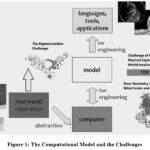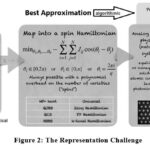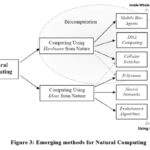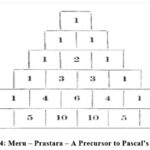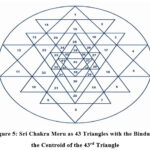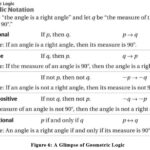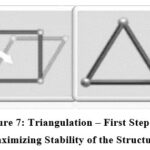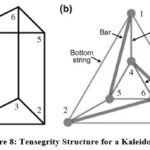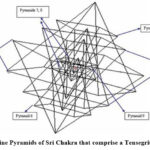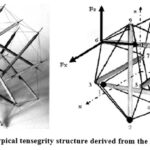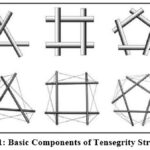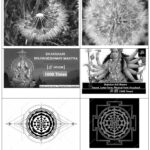Introduction
Geometric logic aims at being the logic of observations of physical
systems and their consequences. “Perpendicular lines intersect at an angle
of 90 degrees” is a declarative sentence that describes a physical reality in
terms of Geometry. Such a sentence can either be true or false. Most geometric
sentences such as this example have a similar quality. They are known as
statements. Combinations of two statements in an if-then structure are called
Conditional statements. Logic is the general study of systems comprising
conditional statements. For any given conditional statement, the truth value of
its converse, contrapositive, and inverse are deducible. This basis of
Geometric logic provides a systematic way for constructing the geometric proofs
for the geometric component of the human mind. Geometry has several
foundational formulae that can make this process algebraic enough. The higher
order geometric structures such as topology and space provide the necessary
scalability for complex and evolving cyber – physical systems.
Geometric Combinatorics stem from
Tropicalization
Degeneration
Stratification
Branch point data
Generating functions
Characteristic classes
John
von Neumann noted that “Anyone who considers arithmetical methods of producing
random digits is, of course, in a state of sin”. A random number is a number
chosen by chance. Quantum systems are inherently probabilistic.
The probability distributions make the numbers in a specified distribution have
equal probability of being chosen randomly. Despite
being formulated post-relativity and post-quantum mechanics, classical Turing
computation is essentially based in the classical physics that forms the
foundation of quantum systems.
The computational model based on the first method and the long-standing challenges are depicted in Figure 1. The representation challenge reflects the inevitable disconnect between real world inspiration and its best approximation as a mathematical model amenable for computation. This disconnect is depicted in the Figure 2. The second and third of the Natural Computing 15 methods are depicted in Figure 3.
The Turing Machine
Alan
Turing contributed to a revolutionary idea: that mental activity is computation.
On the face of it, the associated human intelligence is miraculous.
“The whole thinking process is still rather mysterious to us, but I believe that the attempt to make a thinking machine will help us greatly in finding out how we think ourselves.” – Alan M Turing, BBC Radio Broadcast, 1951.
Some of the open questions in Computational Models are
How do human beings reason, understand language, and remember past events?
What did Alan M Turing contribute to the cognitive-science project?
Did Alan Turing intend that his computational models double up as psychological models and also engineering blueprints?
What is Mind with respect to the Turing Machine?
Human
Brain functions in a manner that it be included in the class of electronic
computers. There is adequate reason to
believe that they could have been classified thus without any change in their
essential properties that specify the pertinent functionality. Alan Turing was in
a group of researchers studying models of computation. Alan Turing proposed a
conceptual model of a “Finite State Machine [FSM]” combined with an infinite
digital tape that could be read and / or written at each step. The input to FSM
is encoded as symbols in conformance to a formal set of grammar rules. FSM
reads tape / writes symbols / changes state until it halts. The solution is
encoded on the tape. Turing’s theoretical computational model is by far the
most robust basis for the computational complexity theory that captures the
essence of the functionality of human brain in the domain of computation. It
has its limitations such as the “Halting Problem” and modeling concurrency. It
is widely understood that the Human Brain performs many concurrent tasks that
are not all necessarily computational. There is plenty of research on variants
of the Turing machines.
The human mind may be construed as having two major components – one with its foundations in biology and behavior / psychology and the other with its foundations in geometry 5. It is the geometric component that includes a language, a tool to use, the mathematical sense of possible realism including multiple realities, and the sense of truth that distinguishes and defines the functioning of the human mind. The notion of “truth” in this manner is very useful in the construction of truth – tables and the essential circuitry that makes the machine called “Computer.” There is no agreement as to whether a universal grammar exists, or whether language as such exists at all. In other words, the square one or start is a decision. There is no need for an agreement as to which square is square-one.
“Natural Computing” is another paradigm. It is one of the approaches to model the natural human mind. Natural computing refers to the following three classes of methods.
Methods that are based on the use of computers to synthesize natural phenomena. This is usually Turing machine or its variants based on methods depicted in Figure 1 and Figure 2.
Methods that take inspiration from nature for the development of novel problem-solving techniques and
Methods that employ natural materials [e.g., molecules] to compute.
Preliminary state – of – art methodologies for Natural Computing 9 are depicted in Figure 3.
“What all of these topics have in common for me is the prospect of increasingly unconventional computing methods that may naturally force us to rethink how we analyze problems for purposes of getting computers to solve them for us.” – Vinton G. Cerf, Communications of the ACM, October 2014, Vol. 57 No. 10, Page 7.
A working definition of “Unconventional” for this paper non-conformance to convention, rule or precedent. Also, the focus of this research is the Geometric Logic and no the mathematical equations with associated symbols.
The Indic Scriptures
The
scientists of ancient India were perhaps called “Rishis.” They made several remarkable
breakthroughs. Often time they make one wonder whether humanity really is at
its peak right now concerning technology.
“Everything in Life is Vibration” – Albert Einstein
The
atoms are in a constant state of motion, and depending on the speed of these
atoms, things
are
appear as a solid, liquid, or gas. Sound is also a vibration and so are
thoughts. Everything that manifests itself in one’s life is there because it
matches the vibration from one’s thoughts.
“Cogito
ergo sum – I think, therefore I am” – Rene Descartes, Principia Philosophiae,
1644.
“Light cannot be anything else but a longitudinal disturbance in the ether, involving alternate compression’s and rarefaction’s. In other words, light can be nothing else than a sound wave in the ether…” – Nikola Tesla 18
“I
think, I think, I hear I am” is the basis of the Sonic Immersion Theory [SIT].
“We have fallen into the place where everything is music. The strumming and flute notes rise into the atmosphere, and even if the whole world’s harp should burn up, there will be hidden instruments playing….” – Jalaluddin Mevlana Rumi, Persian Poet & Sufi Mystic
Indic
scriptures model nature as a state of perpetual motion generating vibrations.
This nature can be accorded a form and can be worshipped / invoked using some
chants or specific sounds. These sounds are classified as swara (vowels) and
vyanjana (consonants). The
Sanskrit alphabet is a set of letter forms that remain a marvel in analysis and
organization. The differentiation of vowels as short (hrasva) and long (deergha)
based on the duration of pronunciation, called maatra (measure) has always been
considered specific to the computation of the potency of a chant.
Srinivasa
Ramanujan is an Indian mathematician who heard and knew infinity as a
visualizable form of the Goddess of Namakkal in Tamil Nadu.
A
syllable is a single, unbroken vowel sound within a spoken word.
This is different from a chant and its associated potency. There
is a separate classification of syllables as laghu (light) or guru (heavy).
This is the basis of generation and classification of chandas (prosody). Each
metre has a different number of syllables.
Acharya
Pingala described the binary number system in his treatise Chandahsastra which
is formal study on poetic meter and verse. This work is dated during the 2nd
Century BC and it is earliest
known work on the binary system that drives the computations in conformance
with the Turing machine and the poetic
meter of the chants. The study is algorithmic.
The
introductory chapter of the “Chandahsastra” deliberates on the concept of
‘gana’. An ancient Indian mathematician and a poet by name Pingala arranged
eight ganas. He developed a method in which the heavy syllable is denoted by 0
and the light syllable denoted by1. When the triplets are written in the order of
the ganas specified by Pingala, and then each triplet mirrored to read units
place onwards, the result is the binary number representations for the numbers
0 to 7 in sequence. Pingala uses the word ‘Shoonya’ to denote Zero. He deals with
six primary prosodical problems and their solutions, i.e. problems concerned
with enumerating and enlisting meters. Pingala does not label these problems. Each
problem and its solution was later called a ‘pratyaya’.
Typically,
the vedic prosody accords specific names to the possible meters. However, the
“Chandahsastra” by Pingala constructs a prastara, a ‘bed’, an expansion or a matrix,
in which the laghus and gurus are listed horizontally. Such a prastara is also
a device to be visualized as an actual table written on a board or on the
ground. Each horizontal line of the table represents a line of a given verse comprising
a sequence of laghu and guru syllables. Every possible combination of the
laghus and gurus is spelled out for a particular meter. Pingala gives a method
of enumeration, which is called prastara, of metres of a given length n (which
indeed are 2n in number), using a recursive procedure.
The binary nature of the syllables and the various possible combinations for letters led to the development of combinatorics 6 such as Meru-Prastara [26], a precursor to Pascal’s triangle seen in Figure 4.
Pingala’s algorithmic approach to the chants 20,12 is also an inquiry into the mysticism of religious and occult geometric figures and the associated spaces. In these spaces any sonic vibration can be accorded a geometric form 21. The algorithms find metrical patterns or their various aspects based on the number of syllables. A three dimensional configuration of Sri Chakra is called ‘Meru Prastara’. Vedic prosody is thus not only the syllables and their ordering as per the Chandas. It is also about the associated geometric visualizations bounded by the Sri Chakra represented as “Meru – Prastara” in three dimensions and “Bhu – Prastara” in two dimensions. All this is fully algorithmic and is amenable to analysis as combinatorics and recursion. These geometric visualizations in the form of interlocking nine triangles, hexagons and surrounding circles are in the space. They form the necessary circuitry of life and the attainment of the chosen divine. The associated vedic prosody or chants now become logic and mathematics expressed in a language for the mind 27 to perceive.
Please see the Figure 5 given below with the ultimate divinity at the Bindu.
Space is always decorated with adjectives. The vedic prosody is replete with adjectives making it amenable for spatial analysis. This is paper is the first to explore these spaces based on the chants. A topological space 1 is roughly a geometrical space in which closeness is defined but cannot necessarily be measured by a numeric distance. It is qualitative and makes possible rule-based reshaping of the geometric forms that are stable under small variations. This property is crucial for dynamical complex cyber physical systems. A doughnut is topologically same as a cup of coffee. The author proposes Tensegrity as an approach to resolve the topological spaces.
Tensegrity
In religion one can believe anything one likes and people use that to their full advantage. The quest for science in such endeavors begins with logic that in some sense is limited to what is and cannot be used to establish anything one wants. The outlandish geometric forms visualized in the Indic scriptures are viable in the context of experiencing the mysticism and providing answers to the meta-physical nature of quantum mechanics 2. This paper is an attempt to transform the vedic prosody into forms amenable for spatial and diagrammatic reasoning 19 inclusive of the seemingly outlandish forms with many heads, many hands and mythical creatures. Geometry 7,14 most often concerns itself with declarative sentences. A declarative sentence is a sentence that asserts the truth or falsehood of something i.e. definitely true of false. Please see the Figure 6. Geometric logic 10 applies to the interrelations among concepts and propositions irrespective of their content, including both semantic and emotional content.
The
term tensegrity was first coined by Kenneth Snelson. It was popularized by
Buckminster Fuller during his experimentation with alternative structural
systems. These structures can be found around the world on a variety of scales
from sculpture to bridges to airports. “Geometry of Thinking” using the
principles of Tensegrity and Reasoning Systems is the crux of this paper. For
the past few decades, it was postulated that human abilities to reason depended
on the formal rules of inference like those found in logical calculus. Reasoning
makes the human rational. Recently, a new approach to reasoning based on the
possibilities that are consistent with the starting point or origin, a
perception of the world, a set of assertions and a memory is being proposed.
Mental models of each distinct possibility are constructed and a conclusion
from them is derived.
A tensegrity structure is one that contains ‘continuous tension members (the wires) and discontinuous compression members (the metal poles) and operates with maximum efficiency’. The first two parts of this definition can be simply applied to human anatomy for the purpose of biocomputing. Tensegrity structure serves as a model for the Cyber – Physical System 8 with the Human – in – the – Loop. A general mathematical model 3 for controllable tensegrity structures is feasible.
The core characteristics of a tensegrity system are:
Omnidirectional
Triangle is the base structure
Triangulation is the basic method
Maximize Stability with Minimum material and hence well aligned for Quantum Mechanics
Scale invariant
Size is a theoretical limit
Non-Linear
Little Energy Consumption
Flexible always in Tension
Rigid Structure in Decompression in Discontinuity
The charge is dealt all over the structure
The author proposes “Chandahsastra” as a representation for analyzing the tensegrity structures. Sri Chakra is a complex, holographic matrix, symbolizing both the microcosm and the macrocosm simultaneously. The Figure 9 and Figure 10 depict the NINE pyramidal structures that can be organized in the form of worshipful “Sri Chakra” with accompanying chants based on the “Chandahsastra”. Please refer to Figure 5 above for the triangles in “Sri Chakra”. The triangulation as shown in the Figure 7 is the first step in maximizing stability of the structure. A Kaleidoscope is modelled as Tensegrity Structure 22 in Figure 8.
The possible geometric equivalences 16 in the topological space is illustrated in the Figure 9. This research is to illustrate some logical foundations for reasoning in Cyber – Physical Systems 22,23 to make their analysis for stability more efficient and life preserving.
Tensegrity structures 17 are specified using continuous tension and local compression. Architecture, Prestress (internal stress prior to application of external force), and triangulation are most critical in terms of determining the mechanical / structural stability. Triangulation involves the use of triangular shapes to give stability to structures. The shape of human body is not maintained by rigid joints and compression. It is maintained by balancing tension across the entire structure of the human body. The vedic prosody represented as Chandas is amenable to envisaging stable structures even though the corresponding forms may appear abstract or outlandish.
The basic components (Cells / Modules) of tensegrity structures 4,11 are shown in Figure 11. An example of a tensegrity structure and its form is shown in Figure 11.
Complex tensegrity structures can be composed
by using these basic components. Some stable derivatives or equivalents in
topological spaces of a tensegrity structure with nine pyramids are shown in
Figure 12.
“Chandahsastra” is the methodology for deriving these equivalents. Indic traditions are seldom about expressions. It is the blissful direct experience of the visualizations stemming from the Chandas i.e the Prosody. Pingala 12 was the first to teach the mathematical model that makes it happen. The visualization is blissful and hopefully beautiful within the tensegrity structures made up of dots, lines circles, triangles and squares. The geometry 12 and the associated logic makes one find the “Shoonya” – the Indic contribution to the World of Mathematics. At this state of “Shoonya” everything is stable, tranquil and self-evident to mention of three attributes. It is a state of the profound natural harmony with the outside but stemming from within.
Conclusions
This research reports the use of Geometric Logic and Reasoning to analyze the stability of Cyber –Physical Systems modelled as Tensegrity structures in topological spaces. Indic traditions thus find the most elusive mathematical basis for the conclusions visualized. Tensegrity structures tend to deflect under major external loads, essentially meaning that the system is ideally meant to only hold its own weight. The structure thus indicates the presence of an external load condition that can be “divinity”.
Acknowledgement
The author places on record sincere thanks to the Programme Committee of FIM-IMIP-UMSO 2021. For the first time three conferences namely:
Forum for Interdisciplinary Mathematics [FIM]
International Symposium on Innovative Management and Production [IMIP]
International Conference on Unconventional Modelling, Simulation and Optimization [UMSO]
were hosted together between 26 – 28 December
2021 at Kitakyushu, Japan. This paper is the outcome of my presentation in the
UMSO 2021 sessions during the triple conference. The supporting organizations
include the International Society of Management Engineers [ISME], Waseda
University, Japan and Multimedia University, Malaysia.
References
- Ali Bajravani, “L-topological spaces”, Sahand Communications in Mathematical Analysis (SCMA), 2018, Vol. 10, No. 1, pp 119-133.
- Baudriller Haïmad, Maurin Bernard, Cañadas Patrick, Montcourrier Philippe, Parmeggiani Andrea and Bettache Nadir,“Form-finding of complex tensegrity structures: application to cell cytoskeleton modelling”, Comptes Rendus Mecanique – C R MEC. 2006, Vol. 334, pp 662-668.
CrossRef - Connelly R and Back Allen, “Mathematics and Tensegrity”, American Scientist. March 1998, Vol. 86, No. 2, pp 142 – 151.
CrossRef - Donald E. Ingber, Ning Wang and Dimitrije Stamenović, “Tensegrity, Cellular Biophysics and the Mechanics of Living Systems”, Reports on Progress in Physics, 2014, Vol. 77, No.4.
CrossRef - Elizabeth Spelke, Sang Ah Lee, and Véronique Izard, “Beyond core knowledge: Natural geometry”, Cognitive Science. 1 May 2010, Vol. 34, No. 5, pp 863–884.
CrossRef - Ezra Miller and Victor Reiner, “What is Geometric Combinatorics? –An Overview of the Graduate Summer School”, IAS/Park City Mathematics Series, 2004, Volume 14.
- Gopal T V, “GAPS: Geometric Analogy Problem Solver”, CSI 1988, 6-9 January 1988, Chennai, INDIA.
- Gopal T V, “Cyber – Physical Systems: Mathematics, Logic and Computation”, Journal of Combinatorics, Information and System Sciences, 2020, Vol. 44, Issues 1-4, pp 151 – 162.
CrossRef - Gopal T V, “Carbon – Silicon Interface”, International Conference Unconventional Modelling, Simulation & Optimization & Management Engineering [UMSO – ISME], 25 – 27 December 2020, Waseda University, Japan.
- Gunawardena, J. “Geometric logic, causality and event structures”. In: Baeten, J.C.M., Groote, J.F. (Eds) CONCUR 1991. Lecture Notes in Computer Science, Springer, Berlin, Heidelberg, 1991, Vol 527.
CrossRef - Ingber D E, Wang N, Stamenovic D, “Tensegrity, Cellular Biophysics, and the Mechanics of Living Systems”, Reports on Progress in Physics, April 2014, Vol. 77, No. 4.
CrossRef - Jayant Shah, “A History of Piṅgala’s Combinatorics”, 2008, Northeastern University, Boston, Massachusetts, 2008.
- Jeremy Gunawardena, “Geometric Logic, Causality and Event Structures”, September 1991, HPL-91-119.
CrossRef - Julia E. Diggins, “String, Straightedge, and Shadow the Story of Geometry”, 1965, Viking Press.
- Leandro Nunes de Castro, “Fundamentals of Natural Computing: An Overview”, Physics of Life Reviews, 2007, Volume 4, Issue 1, pp 1-36.
CrossRef - Matila Ghyka, “The Geometry of Art and Life”, 1977, Dover Publications Inc.
- N. Bel Hadj Ali and I.F.C. Smith, “Dynamic Behavior and Vibration Control of a Tensegrity Structure”, International Journal of Solids and Structures, 2010, Vol. 47, pp 1285–1296.
CrossRef - Orrin E. Dunlap Jr., “Tesla Sees Evidence Radio and Light Are Sound”, 8 April 1934., New York Times.
- Philip N. Johnson-Laird, “Mental models and human reasoning”, PNAS, October 26, 2010, Vol. 107, No. 43, pp 18243–18250.
CrossRef - Pitamber Kaushik and Girish Srinivasan, “How A Poet Founded Mathematics”, 11 April 2020, Heritage Daily.
- Purbita Jana, “Generalised Geometric Logic”, 2021, Semantic Scholar.
- Robert Connolly, “Tensegrity Structures: Why are They Stable?”, In: Rigidity Theory and Applications, M F Thorpe and P M Duxbury (Eds.), 1999, Kluwer Academic / Plenum Publishers.
- Robert E. Skelton and Mauricio C. de Oliveira, “Tensegrity Systems”, 2009, Springer.
- Robert F Woodbury and Irving J Oppenheim, “An Approach to Geometric Reasoning in Robotics”, IEEE Transactions on Aerospace and Electronic Systems, September 1988, Vol. 24, No. 5, pp 630 – 646.
CrossRef - Salman Saghafi, Tim Nelson and Daniel J Dougherty, “Geometric Logic for Policy Analysis”, 2013, Worcester Polytechnic Institute Report, NSF Grant No. CNS-1116557.
- Varshney L.R, “Local fidelity, constrained codes, and the Meru Prastara”, IEEE Potentials, 2008, Vol. 27, pp 27 – 32.
CrossRef - William L Abler, “The human mind: origin in geometry”, Science Progress, 2010, Vol. 93, No. 4, pp 403 – 427.
CrossRef

This work is licensed under a Creative Commons Attribution 4.0 International License.


